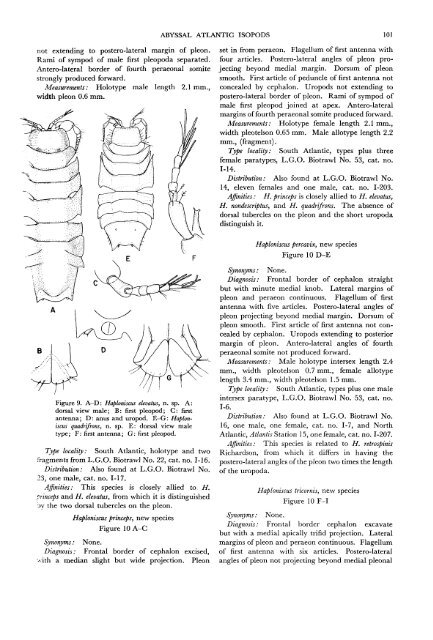The Isopods of Abyssal Depths in the Atlantic Ocean
The Isopods of Abyssal Depths in the Atlantic Ocean
The Isopods of Abyssal Depths in the Atlantic Ocean
Create successful ePaper yourself
Turn your PDF publications into a flip-book with our unique Google optimized e-Paper software.
not extend<strong>in</strong>g to postero-lateral marg<strong>in</strong> <strong>of</strong> pleon.<br />
Rami <strong>of</strong> sympod <strong>of</strong> male first pleopoda separated.<br />
Antero-lateral border <strong>of</strong> fourth peraeonal somite<br />
strongly produced forward.<br />
Measurements: Holotype male length 2.1 mm.,<br />
width pleon 0.6 mm.<br />
Figure 9. A-D: Haploniscus elevatus, n. sp. A:<br />
dorsal view male; B: first pleopod; C: first<br />
antenna; D: anus and uropod. E-G: Haploniscus<br />
quadrifrons, n. sp. E: dorsal view male<br />
type; F: first antenna; G: first pleopod.<br />
Type locality: South <strong>Atlantic</strong>, holotype and two<br />
fragments from L.G.O. Biotrawl No. 22, cat. no. 1-16.<br />
Distribution: Also found at L.G.O. Biotrawl No.<br />
23, one male, cat. no. 1-17.<br />
Aff<strong>in</strong>ities: This species is closely allied to H.<br />
pr<strong>in</strong>ceps and H. elevatus, from which it is dist<strong>in</strong>guished<br />
by <strong>the</strong> two dorsal tubercles on <strong>the</strong> pleon.<br />
Haploniscus pr<strong>in</strong>ceps, new species<br />
Figure 10 A-C<br />
Synonyms: None.<br />
Diagnosis: Frontal border <strong>of</strong> cephalon excised,<br />
•vith a median slight but wide projection. Pleon<br />
ABYSSAL ATLANTIC ISOPODS 101<br />
set <strong>in</strong> from peraeon. Flagellum <strong>of</strong> first antenna with<br />
four articles. Postero-lateral angles <strong>of</strong> pleon project<strong>in</strong>g<br />
beyond medial marg<strong>in</strong>. Dorsum <strong>of</strong> pleon<br />
smooth. First article <strong>of</strong> peduncle <strong>of</strong> first antenna not<br />
concealed by cephalon. Uropods not extend<strong>in</strong>g to<br />
postero-lateral border <strong>of</strong> pleon. Rami <strong>of</strong> sympod <strong>of</strong><br />
male first pleopod jo<strong>in</strong>ed at apex. Antero-lateral<br />
marg<strong>in</strong>s <strong>of</strong> fourth peraeonal somite produced forward.<br />
Measurements: Holotype female length 2.1 mm.,<br />
width pleotelson 0.65 mm. Male allotype length 2.2<br />
mm., (fragment).<br />
Type locality: South <strong>Atlantic</strong>, types plus three<br />
female paratypes, L.G.O. Biotrawl No. 53, cat. no.<br />
1-14.<br />
Distribution: Also found at L.G.O. Biotrawl No.<br />
14, eleven females and one male, cat. no. 1-203.<br />
Aff<strong>in</strong>ities: H. pr<strong>in</strong>ceps is closely allied to H. elevatus,<br />
H. nondescriptus, and H. quadrifrons. <strong>The</strong> absence <strong>of</strong><br />
dorsal tubercles on <strong>the</strong> pleon and <strong>the</strong> short uropoda<br />
dist<strong>in</strong>guish it.<br />
Haploniscus percavix, new species<br />
Figure 10 D-E<br />
Synonyms: None.<br />
Diagnosis: Frontal border <strong>of</strong> cephalon straight<br />
but with m<strong>in</strong>ute medial knob. Lateral marg<strong>in</strong>s <strong>of</strong><br />
pleon and peraeon cont<strong>in</strong>uous. Flagellum <strong>of</strong> first<br />
antenna with five articles. Postero-lateral angles <strong>of</strong><br />
pleon project<strong>in</strong>g beyond medial marg<strong>in</strong>. Dorsum <strong>of</strong><br />
pleon smooth. First article <strong>of</strong> first antenna not concealed<br />
by cephalon. Uropods extend<strong>in</strong>g to posterior<br />
marg<strong>in</strong> <strong>of</strong> pleon. Antero-lateral angles <strong>of</strong> fourth<br />
peraeonal somite not produced forward.<br />
Measurements: Male holotype <strong>in</strong>tersex length 2.4<br />
mm., width pleotelson 0.7 mm., female allotype<br />
length 3.4 mm., width pleotelson 1.5 mm.<br />
Type locality: South <strong>Atlantic</strong>, types plus one male<br />
<strong>in</strong>tersex paratype, L.G.O. Biotrawl No. 53, cat. no.<br />
1-6.<br />
Distribution: Also found at L.G.O. Biotrawl No.<br />
16, one male, one female, cat. no. 1-7, and North<br />
<strong>Atlantic</strong>, Atlantis Station 15, one female, cat. no. 1-207.<br />
Aff<strong>in</strong>ities: This species is related to H. retrosp<strong>in</strong>is<br />
Richardson, from which it differs <strong>in</strong> hav<strong>in</strong>g <strong>the</strong><br />
postero-lateral angles <strong>of</strong> <strong>the</strong> pleon two times <strong>the</strong> length<br />
<strong>of</strong> <strong>the</strong> uropoda.<br />
Haploniscus tricornis, new species<br />
Figure 10 F-I<br />
Synonyms: None.<br />
Diagnosis: Frontal border cephalon excavate<br />
but with a medial apically trifid projection. Lateral<br />
marg<strong>in</strong>s <strong>of</strong> pleon and peraeon cont<strong>in</strong>uous. Flagellum<br />
<strong>of</strong> first antenna with six articles. Postero-lateral<br />
angles <strong>of</strong> pleon not project<strong>in</strong>g beyond medial pleonal

















